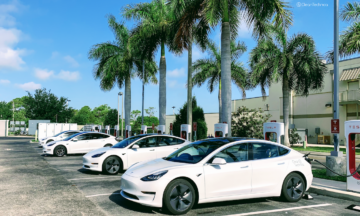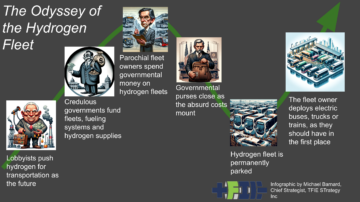The common conception appears to be that a successful transition to electric vehicles is determined by the number of passenger vehicles sold. China, Europe, and the United States lead the way in this category and are thus considered to be at the forefront of EV adoption. However, another metric should be used when analyzing countries with the best approach to electric vehicle development. The emphasis by several South American countries to electrify public transport provides clean transportation to large numbers of the population without having to rely on the importation of large numbers of passenger vehicles. For a continent that is increasingly urban and where transportation plays an oversized part in emissions, Chile, Colombia, and Costa Rica are solving complex problems without the tools available to those in the wealthier countries.
https://bogota.gov.co/mi-ciudad/movilidad/primer-bus-electrico-de-transmilenio-en-bogota
” data-image-caption=”
Image courtesy of Bogota Gov
” data-medium-file=”https://cleantechnica.com/files/2023/04/tmpenalosa2-400×267.jpg” data-large-file=”https://platoaistream.net/wp-content/uploads/2023/04/public-ev-transportation-in-south-america.jpg” decoding=”async” loading=”lazy” class=”size-full wp-image-292410″ src=”https://platoaistream.net/wp-content/uploads/2023/04/public-ev-transportation-in-south-america.jpg” alt width=”640″ height=”427″ srcset=”https://platoaistream.net/wp-content/uploads/2023/04/public-ev-transportation-in-south-america.jpg 640w, https://cleantechnica.com/files/2023/04/tmpenalosa2-400×267.jpg 400w” sizes=”(max-width: 640px) 100vw, 640px”>
Image courtesy of City of Bogota.
South America sees a disproportionate amount of its emissions come from the transportation sector. On average, countries outside of South America receive 22% of their carbon emissions from the transportation sector. By contrast, 35% of the carbon emissions in Latin America come from the transportation sector. On top of this, 81% of the population in South America lives in cities. With urban transport thus having a large impact on both emissions and air quality, 27 Latin America countries have included the electrification of public transport as a priority in their plans to reduce emissions. Leading the way are Chile, Costa Rica, Ecuador, and Colombia. Santiago, Chile, boasts the largest fleet of electric buses of any city outside of China while the cities of Medellin, Cali, and Bogota had 587 electric buses running in Columbia in 2021.
Until passenger EVs become common in South America, countries that do not currently have high levels of electric transport should focus on electrifying buses and taxis. This was reaffirmed in conversation with Jose Luis Torres De La Piedra, an EV specialist currently working in Peru. Torres described the importance of electrifying transportation in cities that are continuously moving. He explained that the first priority to reduce emissions should be electrifying those vehicles which are constantly in motion. In the case of major cities such as Lima, this means electrifying buses and taxis. These vehicles contribute significantly to carbon emissions, which play an oversized role in deaths in Latin America. This is similarly felt in the last-mile logistics for trucks and vans, which are in constant motion, particularly with the boom of e-commerce and the after-effects of the COVID pandemic.
A shift to electric buses and taxis can also disproportionately improve the quality of life of people living in Latin America. With a highly urbanized population, reducing the level of emissions in Latin American cities is crucial to reducing the number of people who die because of air pollution. A report titled Status of Electric Mobility in Latin America and the Caribbean found that “ensuring better air quality by switching to electric mobility can significantly improve human health and prevent deaths.” The electrification of 100% of transport in cities can save thousands of lives. Over 200,000 lives could be saved in Buenos Aires alone from 2019 to 2050 by the electrification of transport.
One of the biggest challenges to reducing emissions from transportation has been the lack of car manufacturers in the region. It is worth noting that the areas in which consumer electric vehicle purchasing is highest have large automobile manufacturing facilities. Whether this is Volkswagen in Germany or Ford in the US, it is understandable that manufacturers are going to sell to their local market first. As more car manufacturers focus on electric vehicles, the numbers of electric vehicles being driven in countries with automobile manufacturers will continue to grow faster than those that do not. Faced with expensive imports of foreign made electric vehicles, it is no surprise that electric passenger cars have not grown rapidly.
While the process of electrifying public transport is an important step in reducing carbon emissions, it is crucial that Latin American countries continue to promote the adoption of electric passenger cars. This is especially true as the region is expected to see a vast increase of consumer vehicles: the number of passenger vehicles in South America is expected to triple by 2050, reaching over 200 million. South American countries should build on their public transport electrification legislation, encouraging the early adoption of passenger EVs and making public charging accessible.
Sign up for daily news updates from CleanTechnica on email. Or follow us on Google News!
Have a tip for CleanTechnica, want to advertise, or want to suggest a guest for our CleanTech Talk podcast? Contact us here.
Solar PV & Farming — Trends In Agrivoltaics
I don’t like paywalls. You don’t like paywalls. Who likes paywalls? Here at CleanTechnica, we implemented a limited paywall for a while, but it always felt wrong — and it was always tough to decide what we should put behind there. In theory, your most exclusive and best content goes behind a paywall. But then fewer people read it! We just don’t like paywalls, and so we’ve decided to ditch ours. Unfortunately, the media business is still a tough, cut-throat business with tiny margins. It’s a never-ending Olympic challenge to stay above water or even perhaps — gasp — grow. So …
Advertisement
- SEO Powered Content & PR Distribution. Get Amplified Today.
- PlatoAiStream. Web3 Data Intelligence. Knowledge Amplified. Access Here.
- Minting the Future w Adryenn Ashley. Access Here.
- Source: https://cleantechnica.com/2023/04/30/public-ev-transportation-in-south-america/
- :has
- :is
- :not
- :where
- $UP
- 000
- 1
- 200
- 2019
- 2021
- 27
- 35%
- 9
- a
- above
- accessible
- Adoption
- Advertise
- AIR
- Air pollution
- alone
- also
- always
- america
- American
- amount
- an
- analyzing
- and
- Another
- any
- approach
- ARE
- areas
- AS
- At
- automobile
- available
- average
- BE
- because
- become
- been
- behind
- being
- BEST
- Better
- Biggest
- Bit
- boasts
- bogota
- boom
- Buenos Aires
- build
- Buses
- business
- but
- by
- CAN
- car
- carbon
- carbon emissions
- cars
- case
- Category
- challenge
- challenges
- charging
- Chile
- China
- chip
- Cities
- City
- cleantech
- Cleantech Talk
- Colombia
- Columbia
- come
- Common
- complex
- conception
- considered
- constant
- constantly
- consumer
- content
- continent
- continue
- continuously
- contrast
- contribute
- Conversation
- COSTA RICA
- could
- countries
- Covid
- crucial
- Currently
- deaths
- decide
- decided
- described
- determined
- Development
- Die
- do
- don
- driven
- e-commerce
- Early
- Ecuador
- Electric
- electric vehicle
- electric vehicles
- Emissions
- emphasis
- encouraging
- especially
- Ether (ETH)
- Europe
- EV
- Even
- Exclusive
- expected
- expensive
- explained
- faced
- facilities
- farming
- faster
- fewer
- First
- Focus
- For
- Ford
- forefront
- foreign
- found
- from
- Germany
- Goes
- going
- Grow
- grown
- Guest
- had
- Have
- having
- he
- Health
- help
- here
- High
- highest
- highly
- However
- http
- HTTPS
- human
- if
- Impact
- implemented
- importance
- important
- imports
- improve
- in
- included
- Increase
- increasingly
- IT
- ITS
- jpg
- just
- Lack
- large
- Latin
- latin america
- Latin American
- lead
- leading
- Legislation
- Level
- levels
- Life
- like
- Limited
- Lives
- living
- local
- logistics
- made
- major
- Making
- Manufacturers
- manufacturing
- margins
- Market
- max-width
- means
- Media
- metric
- mobility
- monthly
- more
- most
- motion
- moving
- New
- news
- no
- number
- numbers
- of
- Olympic
- on
- or
- our
- outside
- over
- pandemic
- part
- particularly
- Patreon
- PayPal
- People
- perhaps
- peru
- plans
- plato
- Plato Data Intelligence
- PlatoData
- Play
- please
- podcast
- Pollution
- population
- prevent
- priority
- problems
- process
- promote
- provides
- public
- purchasing
- put
- quality
- rapidly
- reaching
- Read
- reaffirmed
- receive
- reduce
- reducing
- reducing emissions
- region
- rely
- report
- Role
- running
- s
- Save
- sector
- see
- sees
- sell
- several
- shift
- should
- significantly
- Similarly
- So
- sold
- Solving
- South
- South America
- specialist
- States
- stay
- Step
- Still
- successful
- such
- support
- surprise
- Talk
- team
- than
- that
- The
- their
- then
- There.
- These
- this
- those
- thousands
- tip
- titled
- to
- tools
- top
- transition
- transport
- transportation
- Trends
- Triple
- Trucks
- true
- understandable
- United
- United States
- Updates
- urban
- us
- used
- Vast
- Ve
- vehicle
- Vehicles
- via
- volkswagen
- want
- was
- Water
- Way..
- we
- What
- when
- whether
- which
- while
- WHO
- will
- with
- without
- working
- worth
- Wrong
- you
- Your
- zephyrnet







